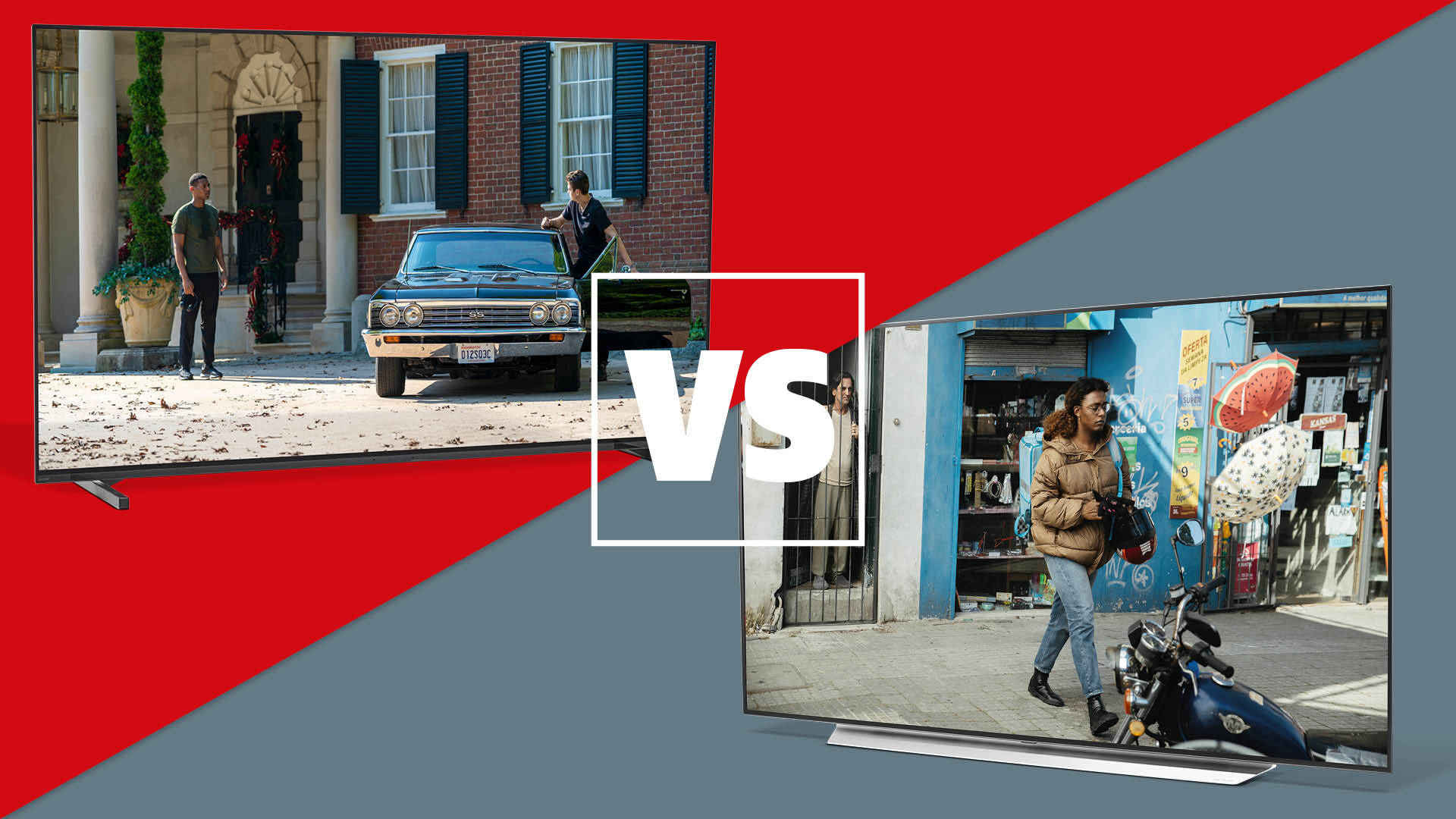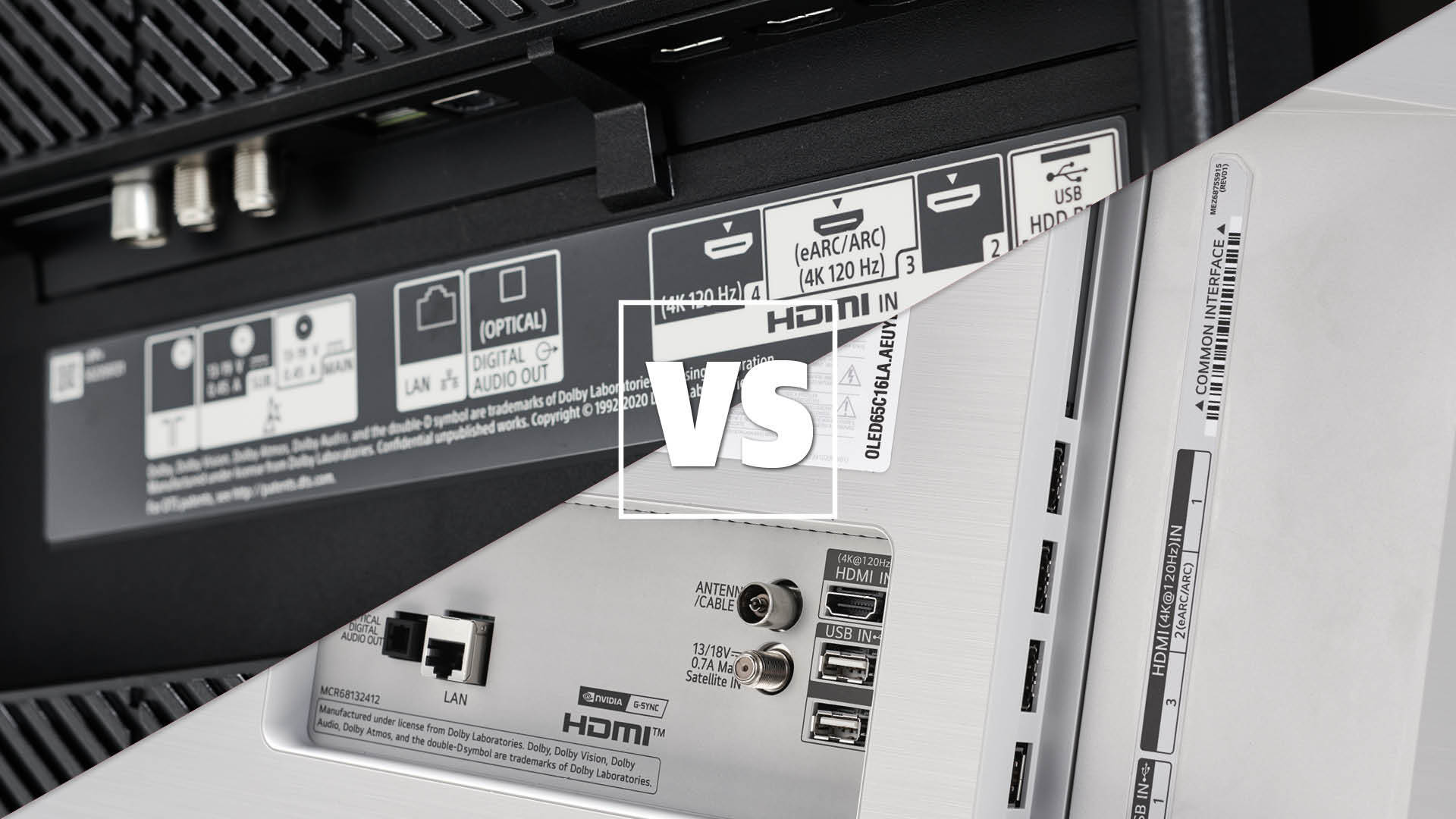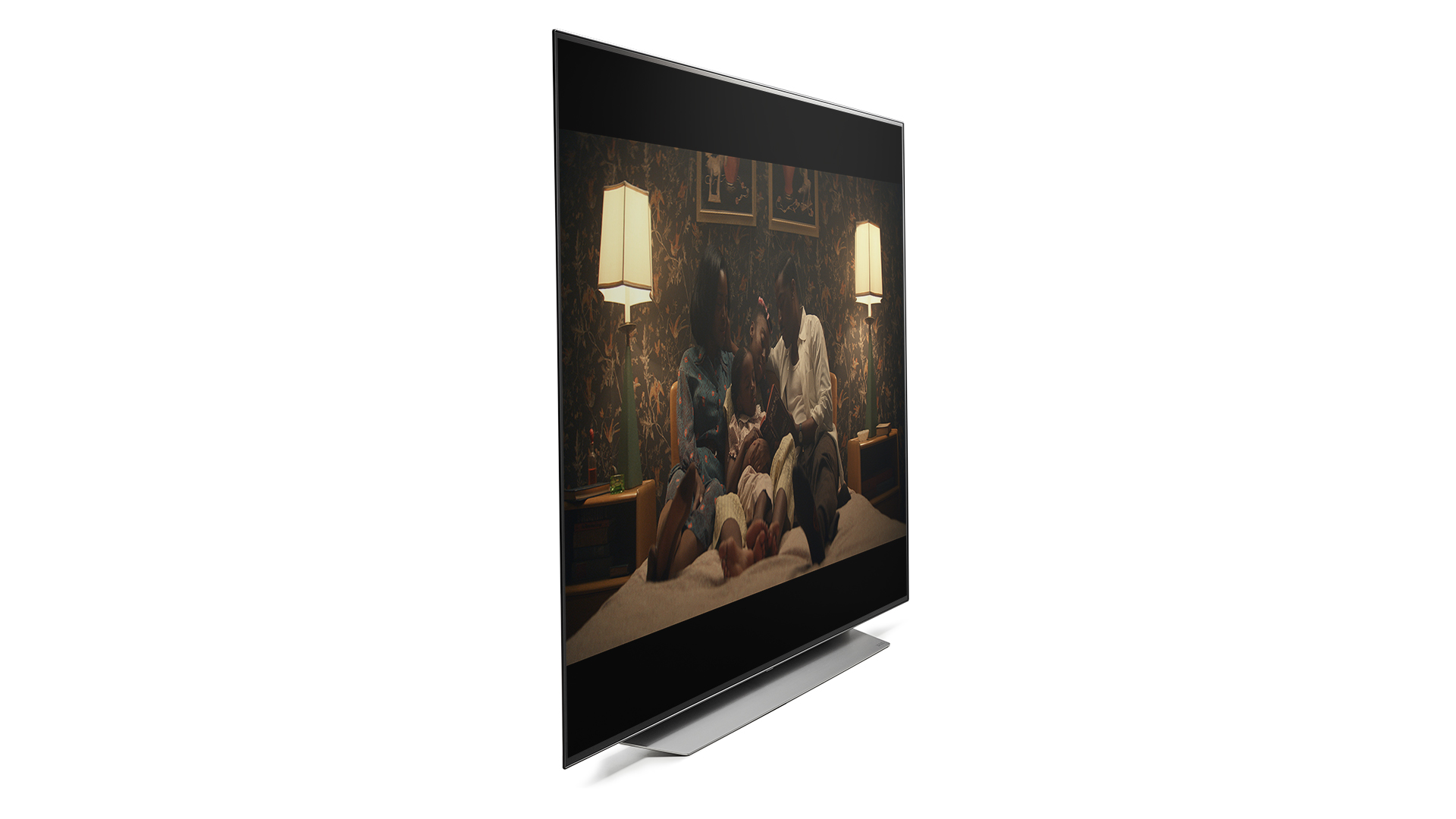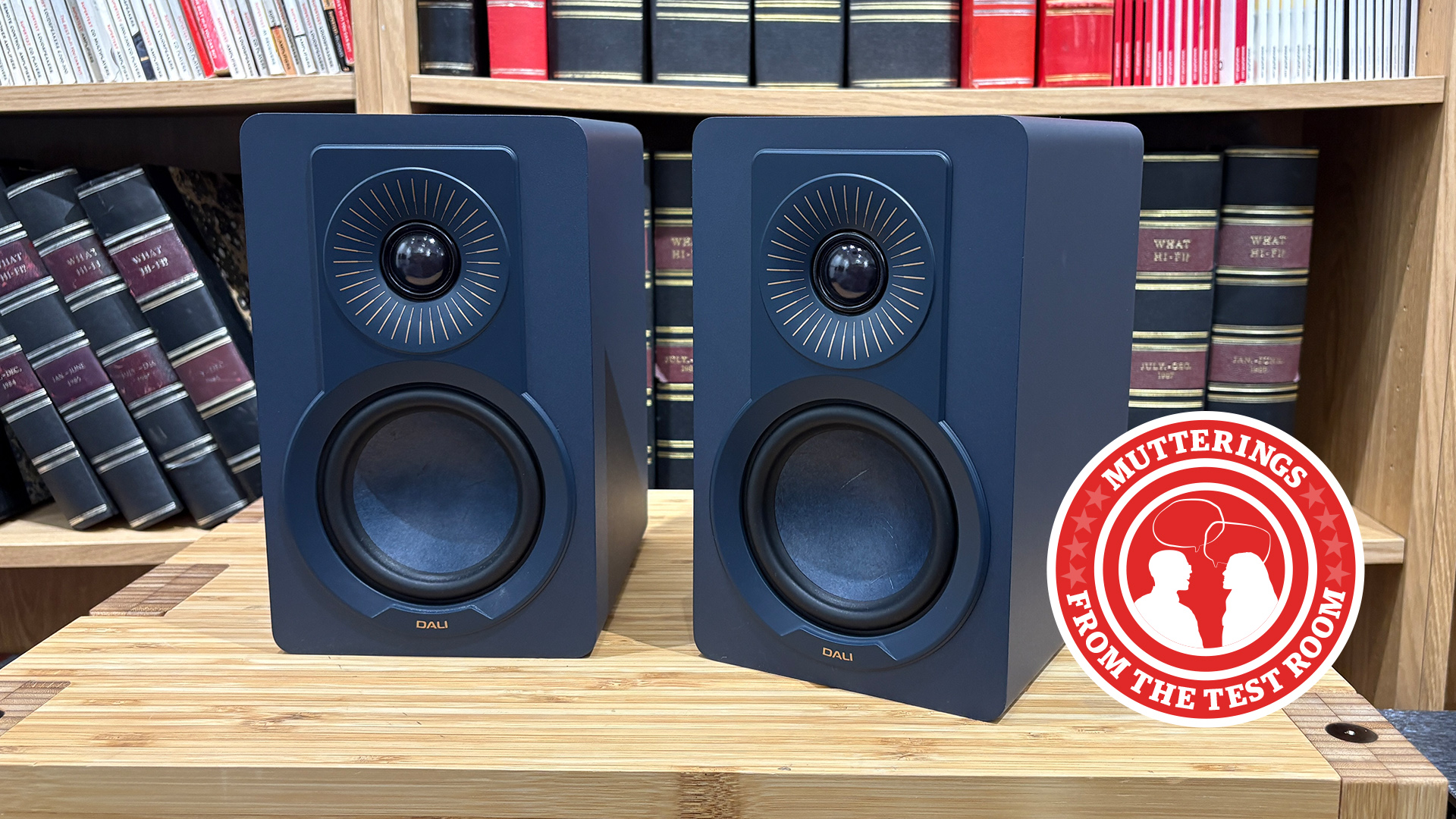Sony A80J vs LG C1: which 4K OLED TV should you buy?
Two performance-per-pound champions do battle

OLED TVs don't have to cost the earth. Despite being one of the most cutting-edge TV screen technologies currently available, OLED has been around for a while now, which means the best OLED TVs are more affordable than ever. Especially if you opt for one that's a rung below the flagship model.
Still far from budget, these are a brand's not-quite-best-of-the-best models: the Quarter Pounder to their Big Mac, if you like. While they might miss out on the odd envelope-pushing new feature, they still offer lots of the same abilities that make the flagship sets such compelling propositions, and that makes them in many cases the better performance-per-pound options.
All the big boys make them, including Sony and LG, which are two of the most revered brands in TVs. Here we're looking at the Sony A80J and LG C1, the step-downs from the A90J and G1 respectively. Both TVs are superb, five-star performers, offering near-flagship specs, feature and performance at more accessible prices. But which is the better buy?
Sony A80J vs LG C1: price
There's not a great deal in it when it comes to price. As you would expect, both are cheaper than their respective flagship siblings. That said, at the time of writing the LG comes out cheaper than the Sony at every size.
The 55-inch Sony XR-55A80J costs £1499 / $1699 / AU$2795, for example, while the 55-inch LG OLED55C1 has recently hit a new low of £1299 / $1499 / AU$2495). It's a similar story at 65 inches: the Sony XR-65A80J comes in at £2199 / $2499 / AU$3795, while the LG OLED65C1 is £1899 / $1900 / AU$3995.
This price difference continues at the bigger sizes. The 77-inch Sony XR-77A80J costs £3599 / $3500 / AU$6995, while the LG OLED77C1 is £3499 / $3299 / AU$6495. The A80J doesn't come any bigger than that, but the C1 comes in an 83-inch (OLED83C1) size that costs £5499 / $5499 / AU$8495.
The C1 also comes in a 48-inch model (OLED48C1), which costs £1099 ($1299, AU$2495).
The latest hi-fi, home cinema and tech news, reviews, buying advice and deals, direct to your inbox.
**Winner** LG C1
With its lower price and greater variety of sizes, the C1 is the clear winner in this round.
Sony A80J vs LG C1: design and build

The C1's design varies very subtly depending on the exact model number of the set. This is denoted by three alphanumerics after ‘C1’, which refer to the region in which the set is sold and potentially the colour of its pedestal, bezels and rear panel. Some versions are also exclusive to certain retailers.
The model we put through its paces in our testing room was the LG OLED65C16LA, which has a pedestal stand that’s a lighter shade of silver than the ‘4LB’ and ‘PUB’ version. It also has a rather unusual white rear panel that could make it slightly easier to find the connection you’re looking for.
But in the grand scheme of things, these are pretty minor differences. For the most part, the 6LA is identical in design to the other C1 models – and last year’s CX which, in turn, was practically identical to the C9 of 2019. Attractive though it is, sticking with the same design for three generations seems a little unambitious, particularly as there are things that could do with changing. For example, while the pedestal stand looks elegant, it's also very heavy, gives the 65-inch model a rather wide footprint of about 92cm (36 inches) and sits the TV quite low, which could be an issue for those who want to add a soundbar.
With the stand removed for wall-mounting, the C1 looks much like any other OLED TV when viewed straight on: a large screen with a thin, flush bezel and no branding. There’s a small protrusion at the centre of the bottom edge that houses the IR sensor and standby light, but that’s about it. Viewed from the side, the set has that typical combination of a thin panel section (about 3mm) and a thicker plastic section that houses the electronics, connections and speakers. This gives the C1 an overall depth measurement of 4.7cm (1.8 inches).
It also comes with the new version of LG’s Magic Remote. The new model arguably looks less interesting than its predecessor, but it’s slightly thinner and feels even better in the hand. The buttons also feel nicer and are better spaced and there are more shortcut buttons to take you directly to specific streaming services. And the much-loved pointer functionality remains.
The Sony A80J contrasts with the C1 by having a logo, but the word 'Sony' is so discreet it's barely noticeable. Like the C1, it sits low by default, but its feet can be repositioned to accommodate a soundbar. In the narrow placement, the 65-inch set's footprint is a very reasonable 86cm (34 inches) wide. That's 6cm narrower than the C1, meaning it'll fit on a wider variety of TV cabinets.
Though at 5.3cm at its thickest point, the A80J is a fraction fatter than the C1.
The Sony's remote can't match LG's. While on first glance it looks just like the flagship A90J's, it lacks a backlight and has disappointingly spongey buttons. Shame.
**Winner** Sony A80J
It might be thicker and have a worse remote, but the Sony A80J takes this round thanks to the freshness of its design and more versatile stand legs.
Sony A80J vs LG C1: features

Sockets-wise, both the C1 and A80J have a decent array of all the usual suspects. Both sport aerial and satellite ports, three USBs and four HDMIs. Though there is one important difference – only two of the Sony's ports are HDMI 2.1, as opposed to all four of the LG's.
The Sony also lacks variable refresh rate (VRR), which next-gen gamers will miss. An update is due before the end of the year but Sony's track record on this sort of thing isn't great.
Like the C1, the A80J supports 4K at 120Hz straight out of the box, but, unlike the C1, using it is not plain sailing. Activating the mode disables both ALLM (Auto Low Latency Mode) and Dolby Vision, and causes dropouts with Dolby Atmos sound. The C1 also supports HGiG, which the A80J doesn't. It broadly means a more impressive and accurate HDR gaming picture. Sony is due to add a feature called Auto HDR Tone Mapping to some of its models, including the A80J, which should do a similar job, though that will only be compatible with the PS5.
All told, a hardcore next-gen gamer will still be better served by the LG C1 than the Sony A80J.
UK readers might remember some of LG's 2020 TVs were lacking some essential catch-up apps such BBC iPlayer – that's because the firm failed to ink a deal with Freeview Play. Thankfully, that's not the case this year, and the C1 ships with all UK terrestrial catch-up apps. Sadly, the same can't be said of the A80J, as it's currently lacking them. Again, they're apparently on the way, and you can send them to your TV from your phone using Chromecast in the meantime, but it's still a rather baffling oversight.
Both sets otherwise offer the usual glut of streaming apps, and the A80J comes with Sony's new Bravia Core app, which streams blockbuster movies at bitrates similar to those of a 4K Blu-ray disc.
LG's long-running webOS operating system comes as standard on the C1, and version 6.0 is a pretty slick experience. We prefer it to the A80J's Google TV platform, though both have their limitations (recommendations being a particular weak spot for both).
Inside the C1 is LG's new AI Processor Gen4. This improves the Object Enhancement feature, and adds a brand new Scene Detection feature. It also improves de-contouring, which should result in less banding of colours, and the dynamic tone mapping algorithm, which LG says results in better contrast and less haloing around bright objects. And in terms of sound, AI Sound Enhancement now has height virtualisation, while the new Auto Volume Levelling feature reduces jarring volume differences as you switch between different apps and sources.
The A80J packs the same Cognitive Processor XR chip as the flagship A90J. This combines the AI abilities of its X1 predecessor with what Sony calls cognitive intelligence – this aims to deliver an AV experience in line with how humans see and hear the world. Scene detection identifies and enhances the main focal points of the image, adding depth. The XR processor looks at multiple zones and other elements (colour, contrast, texture, depth, detail, etc) of each frame and performs a cross-analysis to work out the most important areas.
**Winner** LG C1
A better app selection, slicker user interface and more robust gaming features give this round to the C1.
Sony A80J vs LG C1: picture

The C1 is almost as adept as LG's flagship G1 at handling Dolby Vision content. It’s a beautifully vibrant and solid image with lots of detail and excellent contrast – perfect, pure blacks combine with bright whites to dazzling effect. It's a similar story with HDR10 content, delivering a fabulously punchy and detailed picture with a colour balance that never looks anything other than correct.
But the A80J is certainly no slouch. It's a very punchy performer, and often produces more impactful peaks than the C1. The A80J’s bright highlights are packed with detail, colour and shading that most TVs miss, while at the other end of the contrast spectrum, it prioritises shadow detail over the inky blackness of the C1, digging up extra shades in the darkest parts of the picture. It can still go perfectly black when required, but these extra levels make for a more detailed picture and more involved viewing experience. The A80J clearly produces the sharper and more three-dimensional images of the two TVs, too.
LG has improved its motion handling for this year's TVs, including the C1, but it's still a step behind Sony's industry-leading efforts. The A80J's is just a smoother experience, but one without the sort of artificiality of which many rivals are guilty.
**Winner** Sony A80J
With greater detail in the light and dark parts of the picture and a clear lead in terms of sharpness and motion handling, the Sony takes the picture round.
Sony A80J vs LG C1: sound quality

The C1 is a decent-sounding TV, with an open, spacious soundstage, and a cleanliness to proceedings that a lot of TVs lack. But it's not the most dynamic, lacking a bit of punch and excitement. Switching off Dolby Atmos adds some much-needed pep, but the soundstage is then much narrower and makes the woofers sound a bit flappy when they're confronted by very low bass frequencies.
The A80J is noticeably better. Sony's Acoustic Surface Audio+ makes a real difference – because actuators vibrate the whole screen, it effectively becomes the speaker, with audio inextricably connected to the action on the screen. More traditional subwoofers fill out the bass too, making it weightier and more controlled at the bottom end than the C1. It's significantly punchier and more dynamic, too.
Of course, both TVs will benefit immensely from a soundbar, so add one in if your budget will stretch.
**Winner** Sony A80J
Sony's Acoustic Surface Audio+ makes for a sonic performance with a degree of immediacy that few sets can match.
Sony A80J vs LG C1: verdict
This one is a tale of two halves. The LG C1 comes up trumps in terms of price and features, but it can't match the Sony A80J when it comes to picture and sound performance.
Hardcore next-gen gamers will still be better served by the C1, but if you want the better movie and TV show experience, you're advised – if your budget stretches to it – to opt for the A80J.
MORE:
Flagships do battle: LG G1 vs Sony A90J: which is the best OLED TV?
Get ahead of the game: QD-OLED TV: everything you need to know about the game-changing new TV tech
Get more from your streaming: Amazon Prime Video tips: 4K, HDR, the app and other features
What Hi-Fi?, founded in 1976, is the world's leading independent guide to buying and owning hi-fi and home entertainment products. Our comprehensive tests help you buy the very best for your money, with our advice sections giving you step-by-step information on how to get even more from your music and movies. Everything is tested by our dedicated team of in-house reviewers in our custom-built test rooms in London, Reading and Bath. Our coveted five-star rating and Awards are recognised all over the world as the ultimate seal of approval, so you can buy with absolute confidence.

